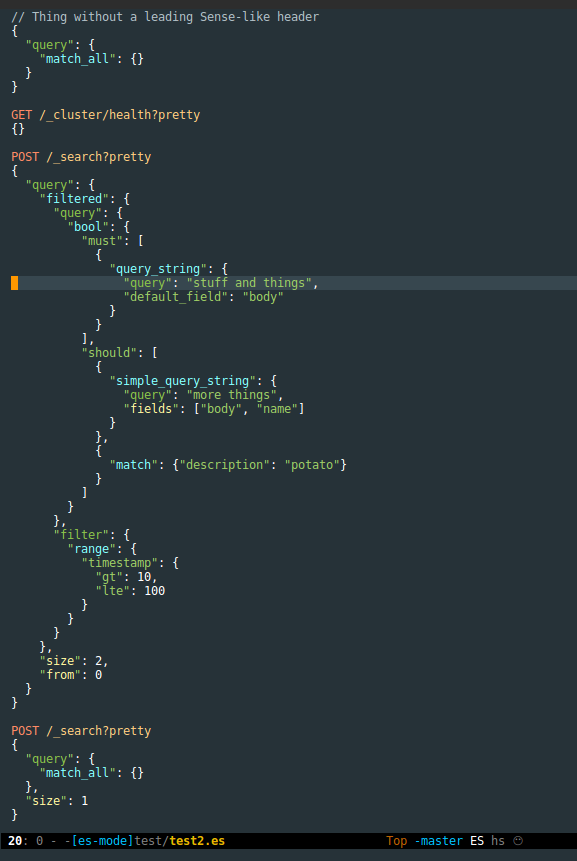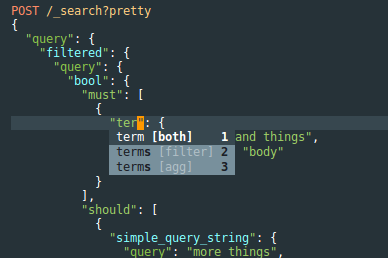Provides a major mode for editing ES query examples. Better highlighting and indention than sh-mode or js-mode.
It is intended to be a mixture of the three modes as well as mimicing some of the highlighting from Marvel's sense console.
You can also think of it as Marvel's Sense-envy for Emacs users.
es-mode is available in the MELPA repository. Do this, if MELPA isn't already in
your sources:
(require 'package)
(add-to-list 'package-archives
'("MELPA" . "https://melpa.org/packages/" ))Then run M-x package-refresh-contents to load the contents of the new
repository, and M-x package-install RET es-mode RET to install es-mode.
(add-to-list 'load-path "/path/to/es-mode-dir")
(autoload 'es-mode "es-mode.el"
"Major mode for editing Elasticsearch queries" t)
(add-to-list 'auto-mode-alist '("\\.es$" . es-mode))You can now open a file with an .es extension and es-mode will
automatically load..
- Highlighting for builtin queries, facets, aggregations, special paramaters
- A company-mode backend for completing ES queries
- Better indenting than sh-mode (indents like js-mode)
- Sending the queries as a http-request to Elasticsearch endpoints.
- navigate via goto-(next|previous)-request with
C-c C-nandC-c C-p(when using parameters) - hooks for responses, see
es-response-success-functionsandes-response-failure-functions - pass the resulting JSON through jq to return only the values you want in org-mode
You can specify requests with two different formats:
In the document, specify parameters similar to Sense, like so:
POST /myindex/_search?pretty
{
"query": {
"match_all": {}
}
}Hitting C-c C-c anywhere on the parameter or body of the request will execute
the request, opening a response buffer. The base-url can be configured by
customizing the es-default-base var.
You also don't have to provide the leading "/", similar to Sense (I personally think the leading "/" looks better though), like this:
POST myindex/_search?pretty
{
"query": {
"match_all": {}
}
}Without any parameters, you can specify a request:
{
"query": {
"match_all": {}
}
}With the request region highlighted or inside the query structure, hit C-c C-c
to execute it. The first time you do this you will be prompted for the URL and
HTTP method. You can also set the URL with C-c C-u and the method with C-c C-m.
See test.es, test2.es, and all.org, here's a screenshot from my theme:
And here's an example of the completion of queries/filters:
One of the main reasons I started this was better highlighting and indention for org-babel. So add the snippet below to your .emacs:
(org-babel-do-load-languages
'org-babel-load-languages
'((elasticsearch . t)))
And then you will be able to hit C-c C-c on code like this in your org-mode
file:
#+BEGIN_SRC es
POST /_search?pretty
{
"query": {
"match_all": {}
}
}
#+END_SRC
OR (without parameters):
#+BEGIN_SRC es :method POST :url localhost:9200/_search?pretty
{
"query": {
"match_all": {}
}
}
#+END_SRC
org-mode uses the arguments :url and :method to know where and how
to send a query. If they are not present org-mode will use
es-default-url and es-defaul-request-method instead.
Tangling these blocks will produce <filename>.es, if you specify the filename
with :tangle foo.sh, es-mode will instead create a curl request for the body
of the request.
Es-mode supports rudimentary table creation from aggregations using the
:tablify header parameter. For example, consider the following aggregations:
#+BEGIN_SRC es :tablify prices :results raw table
POST /test/doc/_search
{
"aggs" : {
"prices" : {
"histogram" : {
"field" : "price",
"interval" : 20,
"min_doc_count": 0
}
}
},
"size": 0
}
#+END_SRC
#+RESULTS:
| key | document count |
|-----+----------------|
| 0 | 4 |
| 20 | 0 |
| 40 | 1 |
| 60 | 2 |
| 80 | 2 |
| 100 | 1 |
| 120 | 0 |
| 140 | 0 |
| 160 | 2 |
Note that the "tablify" argument must be the name of the aggregation to be tablified, in this example, "prices" is the name of the argument.
This also works for terms aggregations:
#+BEGIN_SRC es :tablify my_terms_agg :results raw table
POST /test/doc/_search
{
"aggs" : {
"my_terms_agg" : {
"terms" : {
"field" : "type"
}
}
},
"size": 0
}
#+END_SRC
#+RESULTS:
| key | document count |
|----------+----------------|
| eggplant | 5 |
| foo | 4 |
| widget | 2 |
| cog | 1 |
If you are using org-mode 8.3.1 or later, you can generate pretty ASCII graphs
from org-mode using
orgtbl-ascii-plot
like so (hit C-c C-c on the TBLFM line to generate the graph):
#+RESULTS:
| key | document count | |
|-----+----------------+------------|
| 0 | 4 | WWWWWWWWWl |
| 20 | 0 | |
| 40 | 1 | WWc |
| 60 | 2 | WWWWV |
| 80 | 2 | WWWWV |
| 100 | 1 | WWc |
| 120 | 0 | |
| 140 | 0 | |
| 160 | 2 | WWWWV |
#+TBLFM: $3='(orgtbl-ascii-draw $2 0 5)
Or:
#+RESULTS:
| key | document count | |
|----------+----------------+--------------|
| eggplant | 5 | WWWWWWWWWWWW |
| foo | 4 | WWWWWWWWWl |
| widget | 2 | WWWWV |
| cog | 1 | WWc |
#+TBLFM: $3='(orgtbl-ascii-draw $2 0 5)
Be sure to pass the correct minimum and maximum values for the table (in this
example, 0 and 5) to the orgtbl-ascii-draw method.
Passing JSON through jq
In org-mode you can also reduce the size of results by passing them through the jq command-line tool. For example, compare the output of these two different org blocks:
#+BEGIN_SRC es
GET /
{}
#+END_SRC
#+RESULTS:
#+begin_example
{
"status" : 200,
"name" : "Everyman",
"version" : {
"number" : "1.3.2",
"build_hash" : "dee175dbe2f254f3f26992f5d7591939aaefd12f",
"build_timestamp" : "2014-08-13T14:29:30Z",
"build_snapshot" : false,
"lucene_version" : "4.9"
},
"tagline" : "You Know, for Search"
}
#+end_example
And the same thing, but passed through the jq tool, extracting the "name" and
"version.number" fields:
#+BEGIN_SRC es :jq .name, .version.number
GET /
{}
#+END_SRC
#+RESULTS:
: "Everyman"
: "1.3.2"
You can use this to return only a certain hit, or the score of a hit, etc, easily, so you can format the output as desired. See the full jq manual for how to use jq.
es-mode uses jq in the PATH, however, if you want to specify an absolute
path you can customize the es-jq-path var as you like.
jq will only be run if the response is an HTTP 20[0-9].
This is my first major mode for Emacs, feedback is welcome, especially pull requests that show me what I'm doing wrong.


